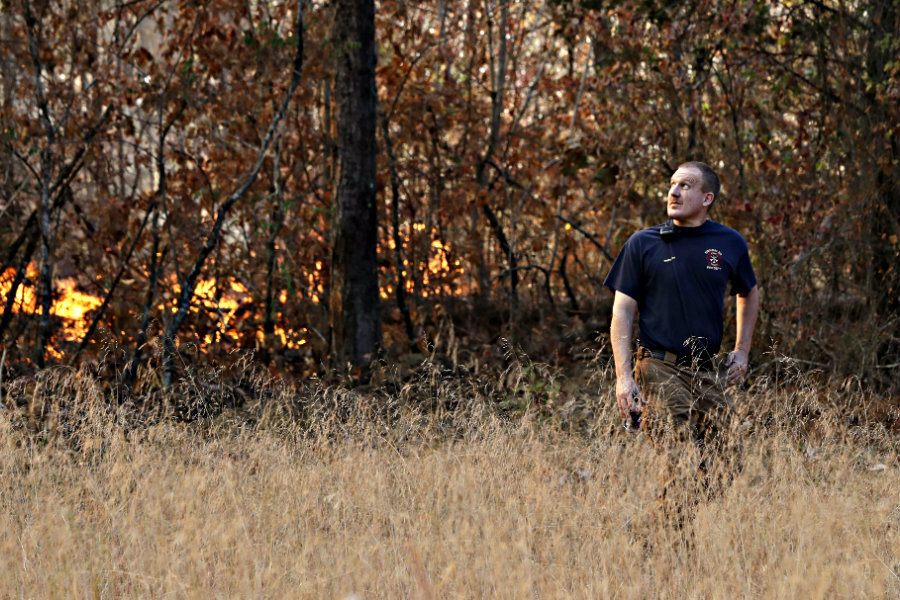Forest fires blaze across Southeast: What is feeding the flames?
Loading...
Residents of several Southern states are encountering an unusual natural phenomenon this week as forests in Georgia, Tennessee, and North Carolina, among others, catch ablaze.
The main culprit this year appears to be an exceptional drought that has parched the Southeastern United States throughout the summer and continued unabated into the fall, after the burn season generally ends.
While wildfires are certainly not unheard of in the region, experts say the extent and severity of this year’s fires set it apart from previous years and that the region may well have to adjust to severe drought conditions like this season’s for the future.
“As humans we seem to have short memories for these things,” says Max Moritz, a fire ecology and management professor at the University of California, Berkeley. “If it just happened to be a dry summer, it might not matter too much in the long term, but if this happens a few years in a row or with increasing frequency, people will have to start doing something about it.”
Wildfires raged in both suburban and rural areas in the Southeast region and the southern Appalachians this week, causing Tennessee’s Department of Environment & Conservation to declare Code Red air quality alerts for Knoxville and the Great Smokey Mountain areas.
In Georgia, the areas around metro Atlanta and the city of Athens, home to the University of Georgia’s flagship campus, were both shrouded in smoke on Thursday due to wildfires in the region. Air quality reports predict that the haze will stick around for at least a day, if not more.
Experts say that while there are generally several ignitions each year, this fall’s fire season has been anything but usual.
“This year stands out as having an unusual, I would even say epic, fire season,” says research ecologist Steven Norman, who works for the USDA Forest Service at its Asheville, N.C., Southern Research Station.
“It is not just a normal fall, we’ve seen an extreme drought.”
Heavy droughts not only prolong the burn season, but they also provide fires with better, drier fodder that can help contribute to the severity of conflagrations. This year’s drought is so severe that nearly 17.5 million people live within drought-afflicted zones in the region, including many people whose homes could be affected by the flames.
But why is this happening now?
In California, where many of the nation’s largest and most severe forest fires take place each year, researchers have done far more to study the connection between seasonal burns and long-term weather trends.
Dr. Moritz tells The Christian Science Monitor that a recent study by his lab found that models predict greater fire incidence on the East Coast than in previous years, as well as around the world. Other studies have linked dryer and warmer climates, which often occur as a symptom of global climate change, with increased fire incidence.
The Monitor’s Jessica Mendoza reported on fire management policy and the modern world in July, writing:
Climate, however critical, is only part of the problem, scientists say. A growing body of evidence suggests that other human activity and policy have at least as much impact on wildfires as climate change. To effectively address a longer and more intense wildfire season – and ensure the safety of residents in fire-prone areas – both environmental and human factors have to be taken into account in more holistic ways, they say.
“We need not just a policy shift but also a cultural shift in the dialogue around fires in our landscape and how to manage them,” says Jennifer Balch, director of Earth Lab and a professor of geography at the University of Colorado in Boulder. “Fire is not something we can remove. A large majority of the country is living in fire-prone areas. How do we live with wildfire? How do we manage?”
Researchers say that it is difficult to know yet whether or not this year’s whopping Southeastern fire season is part of a trend.
“Trends can be difficult to follow when you don’t have long, long-term records, but this year could be the start,” Dr. Norman tells the Monitor by phone.
Nevertheless, the recent fires may be even worse in some areas, simply because they have been so rare in recent years that underbrush and fire fuel has built up, providing food for the flames.
“In some areas, these forests are seeing fires for the first time in decades,” Norman says.
Moritz tells the Monitor that if the droughts do end up being a function of climate change, areas such as the Southeast will have a whole new problem on their hands, coping with the challenges of seasonal fires.
“One would hope that this is a bit of a wakeup call – that we can see that such a short period of drought can create such big problems,” he says.
Norman echoes Moritz’s concerns, adding that in many areas of the southeast, human dwellings are commingled with forest areas.
“It is a slow process for communities to come to terms with the idea that they are living in a fire prone area,” he says, “but clearly wildfires are a more of a concern than they have been for people in this region before now.”
There are some bright spots in the haze for the Southeast, however.
The US Forest Service’s Katie Greenberg, a research ecologist at the Southern Research Station, tells the Monitor that few animal species are likely to be negatively impacted by the burn.
Few animals actually die during forest fires, she says, with burrowing animals retreating below the ground, and more mobile creatures like deer and birds fleeing to safer areas.
Instead of harming many creatures, periodic fires can clear out tree canopies and provide many bird species room to roam.








